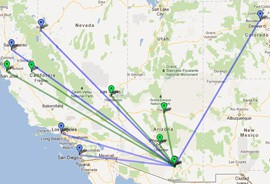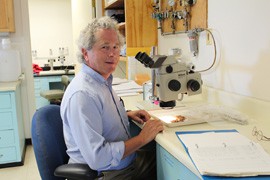Cronkite News has moved to a new home at cronkitenews.azpbs.org. Use this site to search archives from 2011 to May 2015. You can search the new site for current stories.
UA-based center addresses regional climate change
TUCSON – Scientists in Alaska are forecasting the long-term effects on wildlife as permafrost thaws. In Hawaii there’s a study of coral reef health and coastal erosion as sea levels rise. Arizona researchers are studying how much water the Colorado River can supply in prolonged drought.
There’s lots of research being done into the effects and causes of climate change, but to Stephen Jackson, scientists may not know what others are working on and the results may not be communicated in a way that’s useful to decision makers.
“Climate is something that we all have to worry about,” said Jackson, the first director of the Southwest Climate Science Center at the University of Arizona.
The center, established by the U.S. Department of the Interior and managed by the U.S. Geological Survey, is one of eight around the country that coordinate research by universities and scientific institutions. The National Climate Change and Wildlife Science Center in Virginia consolidates the information.
“In order to manage our resources we need the best kind of scientific information to develop the best management strategies to maintain,” Jackson said.
UA was selected in 2010 as the location for the Southwest center. Jackson was appointed to his role recently and is establishing the facility and its staff.
He came from the University of Wyoming, where he was a professor of botany and founded that school’s doctoral program in ecology.
Jackson said the Southwest is one of the most vulnerable regions of the United States to climate change and climate variability. For example, the area sees wide variations in the availability of water based on weather.
“Future changes in precipitation is in the coming decades going to give us some big, whopping droughts and possibly some big flood events,” Jackson said.
Doug Beard, director of the National Climate Change and Wildlife Science Center, said coordination is key in addressing climate challenges.
“The purpose is to really bring the entire breadth of science expertise, wherever it exists, whether it be in the federal government or university system, to help do a better job of planning for future climate impacts,” he said.
In response to an interview request, the Interior Department emailed a statement from Secretary Ken Salazar saying the agency is committed to addressing climate change “head-on.”
“That is why our strategy involves wheels connecting scientists, land managers and land users across the country in a way that will move us all ahead together,” the statement said.
Gregg Garfin, deputy director for science translation outreach at the University of Arizona’s Institute of the Environment, said the Interior Department’s approach offers a chance to integrate climate research.
“In the past a lot of research has been restricted between just looking at water issues, just looking at environmental-management issues and just looking at wildlife issues,” Garfin said.
While climate change stirs intense political debate over causes or even whether it exists, Jackson said the Southwest Climate Science Center will keep its focus on the science.
“Setting aside any kind of human activities that are going on now, nature by itself is capable of throwing some serious curveballs and fastballs and knuckleballs … and we need to be prepared to deal with those as they come,” he said.











